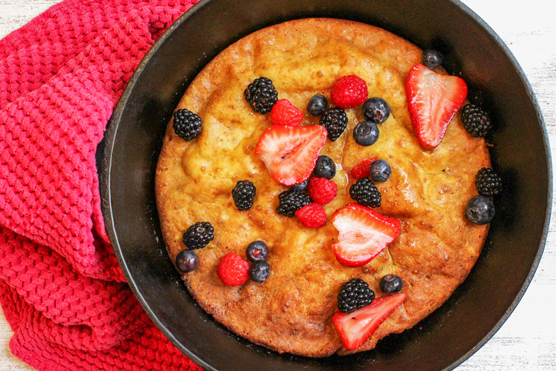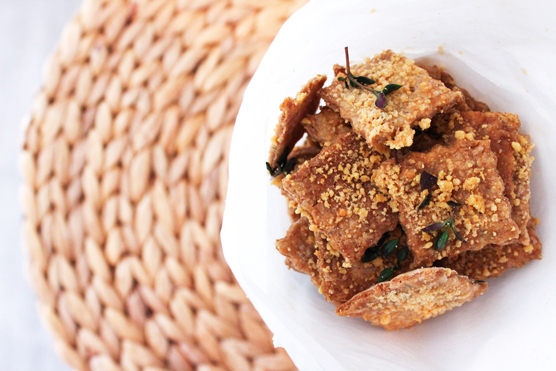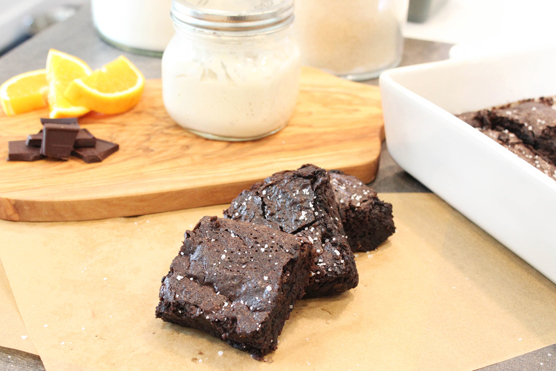Schnell, bevor Sie Ihren Sauerteig wegwerfen, schauen Sie sich diese Rezepte an. Entsorgen enthält Mehl, Wasser und, ja, Hefe. Es hat also einen kleinen Anstieg, einen leicht säuerlichen Geschmack und verdickende Kräfte.
Wenn Sie versuchen, ein Rezept zu manipulieren und Ihren Sauerteig- Abfall zu werfen , sollten Sie es sich so vorstellen: 120 Gramm Abfall sind 60 Gramm Mehl und 60 Gramm Wasser, also etwa 1/2 Tasse Mehl und 1 /4 Tasse Wasser. Dies muss in einem bestehenden Rezept ersetzt werden, um erfolgreich verwendet zu werden. Viele Leute wissen, dass der Abfall in Muffins und Schnellbroten gut funktioniert, aber in diesem Artikel finden Sie einige süße und herzhafte Möglichkeiten, Ihren übrig gebliebenen Abfall zu recyceln.
Nehmen Sie den Starter aus dem Kühlschrank. Lassen Sie den Starter revitalisieren und sprudeln Sie, um sich zu verdoppeln. Ziehen Sie, was Sie für ein Brotrezept brauchen. Nehmen Sie dann 50 Gramm zum Füttern und starten Sie ein weiteres Glas Starter (50 Gramm Starter, 50 Gramm Mehl und 50 Gramm Wasser). Die restliche Menge können Sie kreativ in einem anderen Rezept verwenden.
Gebackene Dutch Oven Pfannkuchen

Gebackene Dutch Oven Pfannkuchen
Zubereitungszeit: 5 Minuten
Backzeit: 20 Minuten
Ausbeute: 6 Portionen
Zutaten
57 Gramm (1/4 Tasse) ungesalzene Butter
6 Eier
454 Gramm (2 Tassen) Sauerteigstarter
82 Gramm (1/3 Tasse) Milch
4 Gramm (1 Teelöffel) Vanilleextrakt
13 Gramm (1 Esslöffel) Zucker
3 Gramm (1/2 Teelöffel) Salz
Richtungen
Den Ofen auf 400 Grad F vorheizen.
In einem großen Dutch Oven die Butter bei mittlerer Hitze erhitzen.
Währenddessen in einer großen Schüssel Eier, Sauerteigstarter, Milch, Vanille, Zucker und Salz verquirlen. (Behalte die Butter im Auge, während sie schmilzt, um sicherzustellen, dass sie nicht anbrennt.)
Wenn der Ofen aufgeheizt ist, fügen Sie die Pfannkuchenmischung zur geschmolzenen Butter hinzu und schwenken Sie sie im Dutch Oven.
Vom Herd nehmen und 20 Minuten backen oder bis sie geschwollen und goldbraun sind.
Sofort servieren.
Pro Portion: Kalorien 303 (aus Fett 125); Fett 14g (gesättigt 7g); Cholesterin 233 mg; Natrium 273 mg; Kohlenhydrate 34g (Ballaststoffe 3g); Eiweiß 12g.
Bewahren Sie diese Pfannkuchen bis zu 2 Tage im Kühlschrank auf.
Wenn Sie Ihre Vorspeise mit Roggenmehl füttern, erhalten diese Pfannkuchen einen einzigartigen und interessanten Geschmack.
Mit frischen Beeren und Ahornsirup servieren oder mit Puderzucker bestreuen.
Variiere es! Zitronenschale in den Teig geben und mit frischen Blaubeeren und einem Spritzer Zitronensauce (aus Zitronensaft und Puderzucker hergestellt) servieren.
Sauerteigfladenbrot
Zubereitungszeit: 15 Minuten plus 1 Stunde zum Aufgehen
Backzeit: 6 Minuten
Ausbeute: 6 Portionen
Zutaten
227 Gramm (2 Tassen) Allzweckmehl
6 Gramm (1 Teelöffel) Salz
2 Gramm (1/2 Teelöffel) Backpulver
113 Gramm (1/2 Tasse) Sauerteigstarter
82 Gramm (1/3 Tasse) Naturjoghurt
60 Gramm (1/4 Tasse) Rapsöl, geteilt
28 Gramm (2 Esslöffel) Butter
Richtungen
In einer großen Schüssel Mehl, Salz und Backpulver vermischen.
Vorspeise, Joghurt und 2 Esslöffel Rapsöl einrühren.
Den Teig zu einer Kugel formen.
Streuen Sie etwa 1/4 Tasse bis 1/2 Tasse Mehl auf eine ebene Fläche.
Den Teig auf die bemehlte Fläche legen und nach Bedarf mehr Mehl einkneten. Der Teig sollte geschmeidig sein, weder trocken noch nass.
Etwa 5 Mal kneten.
Den Teig mit Plastikfolie abdecken und 1 Stunde ruhen lassen.
Teilen Sie den Teig in 6 gleiche Stücke.
Rollen Sie jedes Teigstück in eine runde oder längliche Form (je nachdem, was Sie bevorzugen). Für ein dünneres Fladenbrot auf 10 Zoll ausrollen; Für ein dickeres Fladenbrot auf 8 Zoll ausrollen.
In einer kleinen hitzebeständigen Schüssel die Butter schmelzen und mit den restlichen 2 Esslöffeln Rapsöl mischen.
Heat a large Dutch oven over medium-high heat.
Brush the tops of the bread with the butter-and-oil mixture.
Cook each flat bread for 2 to 3 minutes on each side or until it puffs up and begins to brown with bubbles.
Per serving: Calories 296 (From Fat 122); Fat 14g (Saturated 3g); Cholesterol 11mg; Sodium 435mg; Carbohydrate 38g (Dietary Fiber 2g); Protein 6g.
Flatbreads are best consumed the day they’re prepared.
The range in flour for kneading is based on the starter. Some starters are more wet, due to humidity in the air. The dough should feel like pizza dough.
Serve with hummus, grilled meats, or as part of a charcuterie board.
Vary it! Add roasted garlic and chopped herbs (cilantro, parsley, or thyme) for a pop of flavor.
Fluffy Biscuits
Prep time: 15 minutes
Bake time: 12 minutes
Yield: 12 servings
Ingredients
240 grams (2 cups) all-purpose flour
14 grams (1 tablespoon) baking powder
5 grams (1 teaspoon) baking soda
6 grams (1 teaspoon) salt
113 grams (1/2 cup) cold unsalted butter
454 grams (2 cups) sourdough starter
28 grams (2 tablespoons) salted butter, melted
Directions
In a medium bowl, whisk together the flour, baking powder, baking soda, and salt.
Using a pastry cutter or your fingers, cut the cold butter into the flour mixture until the small butter crumbles.
Add in the sourdough starter and stir to combine.
Preheat the oven to 450 degrees F.
On a lightly floured flat surface, place the biscuit dough.
Knead the dough 3 times and flatten into a 12-x-12-inch square.
Brush the tops with the melted butter.
Cut the dough into 12 biscuits, about 2 x 2 inches.
Line a baking sheet with parchment paper.
Place the biscuits on the parchment paper.
Place the baking sheet in the oven and immediately reduce the heat to 425 degrees F.
Bake for 12 to 15 minutes or until golden brown and cooked through.
Per serving: Calories 231 (From Fat 91); Fat 10g (Saturated 6g); Cholesterol 25mg; Sodium 448mg; Carbohydrate 31g (Dietary Fiber 2g); Protein 5g.
Store in an airtight container at room temperature for up to 2 days.
Biscuits perform better when everything is cold. If it’s a hot day, place all the dry ingredients in the refrigerator and let them chill before adding in the starter.
Serve with fresh jam and whipped honey butter, like honey cardamom butter.
Vary it! Craving a savory biscuit? Add 1 tablespoon fresh thyme leaves and 1/2 teaspoon garlic powder.
Cheesy Kinder Crackers

Cheesy Kinder Crackers
Prep time: 15 minutes plus 1 hour for rising
Bake time: 25 minutes
Yield: 8 servings
Ingredients
100 grams (3/4 cup plus 1 tablespoon) whole-spelt flour or whole-wheat flour
170 grams (3/4 cup) sourdough starter discard
50 grams (1/4 cup) room-temperature unsalted butter
3 grams (1 tablespoon) chopped thyme leaves
4 grams (3/4 teaspoon) salt
Extra-virgin olive oil, for brushing or spraying the surface of the crackers
58.7 grams (1/4 cup) grated Parmesan
Directions
In a medium bowl, mix together the flour, starter, butter, thyme, and salt.
Knead the dough into a ball.
Divide the dough in half and tightly wrap each rounded dough with plastic wrap.
Place the wrapped dough in the refrigerator for 1 hour.
Lightly flour a flat surface.
Working with one piece of dough at a time, roll out the dough into a square, about 1/8-inch thick.
Place a piece of parchment paper on a baking sheet.
Place the dough on top of the parchment paper.
Brush or spray the top of the dough with olive oil and sprinkle with 2 tablespoons grated Parmesan cheese.
Using a pizza cutter or a sharp knife, cut the dough into 1-inch squares. (It’s okay if the squares aren’t perfectly shaped.)
Preheat the oven to 325 degrees F.
Bake for 20 to 25 minutes or until golden brown.
While the first batch of crackers is baking, roll out the second batch of dough.
Place a piece of parchment paper on a baking sheet.
Place the dough on top of the parchment paper.
Brush or spray the top of the dough with olive oil and sprinkle with 2 tablespoons grated Parmesan cheese.
Using a pizza cutter or a sharp knife, cut the dough into 1-inch squares.
After you’ve removed the first batch from the oven, place the second batch in the oven and bake for 20 to 25 minutes or until golden brown.
Per serving: Calories 142 (From Fat 58); Fat 6g (Saturated 4g); Cholesterol 16mg; Sodium 244mg; Carbohydrate 18g (Dietary Fiber 2g); Protein 4g.
Store in an airtight container at room temperature for up to 5 days.
Serve with thinly sliced apples, tomatoes, or salami for an afternoon snack.
Vary it! Add in 1/4 cup sesame seeds and cracked black pepper for a savory spin.
Beer-Battered Vegetable Tempura
Prep time: 30 minutes
Bake time: 2 minutes
Yield: 4 servings
Ingredients
872 grams (4 cups) avocado or grapeseed oil, for frying
454 grams (2 cups) sourdough starter discard
2 eggs
1 gram (1/2 teaspoon) paprika
1 gram (1/2 teaspoon) black pepper
3 grams (1/2 teaspoon) salt
8 asparagus spears
16 green beans
1 sweet onion, thickly sliced into rings
1 medium sweet potato, roasted and cooled and sliced into 1/2-inch circles
120 grams (1/2 cup) ranch dressing, for dipping
Directions
In a Dutch oven or deep skillet, heat the oil to 355 degrees F.
Meanwhile, in a medium bowl, mix together the starter, eggs, paprika, pepper, and salt.
Place the asparagus, green beans, onion, and sweet potato into the batter and toss to lightly coat.
Place a brown paper bag or paper towels on a baking sheet.
When the oil has heated, work in small batches to cook the tempura vegetables. Add 4 to 6 vegetable pieces in at a time and cook the vegetables for 2 to 3 minutes, or until golden brown, flipping the vegetables periodically as they fry.
Remove the vegetables to the baking sheet to cool.
Return the oil temperature to 355 degrees F and then add in the next batch of vegetables.
Check the seasoning, and salt if needed.
Serve the tempura vegetables with the ranch dip.
Per serving: Calories 448 (From Fat 162); Fat 18g (Saturated 2g); Cholesterol 106mg; Sodium 348mg; Carbohydrate 62g (Dietary Fiber 7g); Protein 13g.
These are best consumed the day they’re prepared.
To preroast the sweet potato, slice it into rings and roast at 400 degrees F for 15 to 20 minutes or until slightly tender. The idea is that the sweet potato is mostly cooked, because it won’t be fried long enough to fully cook the vegetable.
Vary it! You can use a variety of vegetables, like mushrooms squash, zucchini, broccoli, or potatoes. Pre-cook harder vegetables by blanching, boiling, microwaving, or roasting. This is a fun way to repurpose leftover vegetables!
Salted Dark Chocolate Brownies

Salted Dark Chocolate Brownies
Prep time: 15 minutes
Bake time: 45 minutes
Ausbeute: 9 Portionen
Zutaten
150 Gramm (5,3 Unzen) dunkle Schokolade (65% bis 70% Kakaomasse), in kleine Stücke gebrochen
50 Gramm (1/4 Tasse) ungesalzene Butter
40 Gramm Rapsöl (1/4 Tasse)
6 Gramm (1 groß) Orange, abgerieben
36 Gramm (3 Esslöffel) gebrühter Kaffee oder Espresso
3 Gramm (1/2 Teelöffel) Salz
2 Gramm (1/2 Teelöffel) Vanilleextrakt
120 Gramm (1/2 Tasse plus 2 Esslöffel) Sauerteigstarter
150 Gramm (2/3 Tasse) Zucker
110 Gramm (1/2 Tasse, verpackt) hellbrauner Zucker
25 Gramm (1/4 Tasse) ungesüßtes Kakaopulver
25 Gramm (1/4 Tasse) Allzweckmehl
3 Eier
3 Gramm (1/2 Teelöffel) grobes Meersalz, zum Bestreuen
Richtungen
Schokolade und Butter in eine mikrowellengeeignete Schüssel geben und 1 Minute auf höchster Stufe in die Mikrowelle stellen und nach 30 Sekunden umrühren.
Rühren, um die restlichen Schokoladenstücke zu schmelzen.
Rapsöl, Orangenschale, Kaffee, Salz und Vanille zur geschmolzenen Schokolade geben und umrühren.
Wenn sich die Schokolade leicht warm anfühlt, mischen Sie Vorspeise, Zucker, hellbraunen Zucker, Kakaopulver, Mehl und Eier unter.
Den Ofen auf 350 Grad F vorheizen.
Sprühen Sie ein 9 x 9 Zoll großes Backblech oder eine Glasauflaufform mit Kochspray ein.
Den Teig in die Form gießen und 45 bis 50 Minuten backen oder bis eine Innentemperatur von 190 Grad F erreicht ist.
Streuen Sie das Meersalz darüber, während die Brownies abkühlen.
Pro Portion: Kalorien 353 (aus Fett 158); Fett 18g (gesättigt 8g); Cholesterin 83 mg; Natrium 289 mg; Kohlenhydrate 47g (Ballaststoffe 3g); Eiweiß 5g.
Hinweis: In einem luftdichten Behälter im Kühlschrank bis zu 3 Tage lagern.
Variiere es! Fügen Sie gehackte Pekannüsse oder Walnüsse für ein wenig Crunch hinzu.





